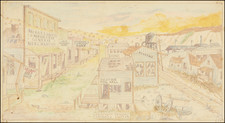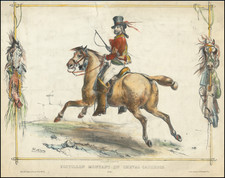1934 Letter From James Gang Member Billy Stiles -- 26 Years After His Death!
Fascinating and rambling letterwritten by "Bill Stiles", including a lengthy account of the outlaw Jessie James, his first killing, observations on Jessie James and Frank James (he was braver than Jessie), and Belle Starr (the planner of their crime spree).
Bill Stiles was the legendary "Ninth Member " of the Jesse James Gang, who was believed to have died September 7, 1876 during a robbery attempt in Northfield, Minnesota. Notes on his death continue uintil now, with the following gleaned from " The Jesse James Gang: What Happen to Them, Old West Kansas" :
Born in Nova Scotia into a family with one daughter. Family shows in Minneapolis 1870 census. Known by local sheriff as a two-bit horsethief. How he became involved with Jesse James is unknown, but it was probably him who suggested the Minnesota robbery. He was killed at Northfield in 1876, and his body put on display there. The body was claimed by his sister, who came from Minneapolis with her husband, and took him away. The family does not show in the 1880 census. Probably did not use Bill Chadwell as an alias, since most historians are confused about the identity of these two men.
Captured in the robbery were three members of the James-Younger gang: Cole, Jim and Bob Younger. Two unidentified men believed to be Frank and Jesse James escaped. Three robbers were killed: Clell Miller, Charlie Pitts and Bill Chadwell, aka Bill Chadwick, aka Bill Stiles.
The identity of the third dead man, Chadwell/Chadwick/Stiles, is inconclusive, which lends credence to the theory that a ninth man who lived to tell about the raid surfaced years later in Los Angeles. One of many pieces of evidence Koblas uncovered, is a report that Bill Stiles' father traveled from Grand Forks, North Dakota, to Northfield to identify his son's body. But he left town relieved that the man he was shown wasn't his son.
Bill Stiles, a Minnesota-born career criminal, underwent a religious conversion at the Union Rescue Mission in Los Angeles in 1913. In 1931 he granted an interview to Ed Earl Repp, a writer of science fiction and sensational Old West stories. Though Stiles complained that Repp's published account of the interview was embellished, it did make public Stiles' "confession" that he was the ninth man in the Northfield raid, waiting on the edge of town, unseen by witnesses.
The Wikipedia entry for Stiles tells a completely different story, summarized below.
Born in Casa Grande, Arizona, Stiles worked as a prospector and ranch hand in the Superstition Mountains. He later became a lawman working under Jeff Milton and John Slaughter, having a reputation as an expert tracker. Eventually meeting Willcox marshal Burt Alvord, the two formed a partnership and were very successful robbing trains in southern Arizona with "Three Fingered" Jack Dunlop, Bravo Juan Yolas, Bob Brown and brothers George and Louis Owens. Under the guise of deputy sheriffs, they were able to interfere with investigations by local authorities.
In 1899, they were apprehended attempting to rob the Southern Pacific Railroad. The two had a minor falling out over the incident with each blaming the other and Stiles wife also testified against him in court. Alvord soon broke him out of jail however, tying up the jailer and freeing Stiles from his cell with the keys, and the two disappeared from the area. The gang went in different directions following the February 15, 1900 shootout between five members of the gang, and lawman Jeff Davis Milton, which resulted in Dunlop being killed, and both gang member Bravo Juan Yaos and Milton being wounded. Stiles, however, is alleged to have not been present during that robbery attempt.
In 1902, Alvord and Stiles assisted the Arizona Ranger Burton C. Mossman with the capture of the Mexican bandit Augustine Chacon. After that, Stiles surrendered to Mossman and briefly served in the Arizona Rangers. The roster of Arizona Rangers shows that Stiles was thirty-two when he enlisted. He did, however, turn back to banditry soon after.
Back in Mexico, Alvord and Stiles attempted to fake their own deaths by sending two coffins with their supposed bodies to Tombstone. The ruse was quickly uncovered though and in late 1903 a group of Arizona Rangers entered Mexico to find the two bandits. While successfully capturing Alvord, Stiles was able to escape the country making his way to the Orient, spending considerable time in China and the Philippines. Stiles eventually returned, and became a deputy sheriff in Humboldt County, Nevada under the name William Larkin. On December 5, 1908, he was killed when trying to deliver a court summons. The suspect had opened fire on Stiles as he approached the suspects barn, hitting him three times. The suspect was arrested, but for unknown reasons was acquitted during the trial.
On March 7, 1924, an article in the Bakersfield California noted that Stiles was still alive, stating:
BILLY STILES, EX-BANDIT COMRADE OF JESSE JAMES By JACK JUNGMEYER (Special to The Californian)
GLENDALE, Calif., March 7.-Tho only surviving member of Jesse James' gang / a hero-reformed! William Stiles Is a disturbing refutation of the proverb that you cun't straighten the bough. Billy In boyhood and prime was as crooked a bough as was ever fashioned by the, storms of outlawry. Today, at the age of 74, Is as straight "human tree as ever weathered .... He does odd jobs on a farm and writes a book between chores. 'I was bad from the time I can first remember," explains Stiles. '"I started stealing as soon as I could walk." But When he reached that age when most men consider their lives unalterably fixed, Stiles began to delve Into the gospel instead of bank vaults and mail pouches. His first crime was at 14. He robbed drunken man. He ran away from home and went to a New York "begging school," where he mastered pick-pocketing. After he had stolen a horse In Kentucky-a gallows offense In those days -he decided to go the limit and joined the James' gang. My Initiation was pretty rough," he recalls. "They sent me out on an errand along the trail. Soon I saw men-sheriffs' deputies, I thought-surround me. I thought I was lost. .When they asked me If I bo- longed to the James' gang, I couldn't say 'yes' because I thought they would hang me. And If I said 'no.' I figured the gang would kill me. So I refused to answer. "They put a rope around my neck and hoisted me clear of the ground several times. Finally the released me and I returned to the camp.
It is quite possible that the letter was writtenby an impostor and that his story above is fiction, but still great fun and certainly the same character from the Bakersfield Californian article wrote this letter.









![[ Virginia Natives -- The Conjurer ] Praestigiator](https://storage.googleapis.com/raremaps/img/small/98754.jpg)

![[Charles Lindbergh - 1st Trans-Atlantic Flight - Printed on Linen]](https://storage.googleapis.com/raremaps/img/small/69233.jpg)
![(Waterfalls of the World) Tableau Comparatif De La Hauteur Des Chutes D'eau Les Plus Celebres. Dedie a la Societe de Geographie . . . Par un de ses Membres: Louis Bruguiere [Comparative Table of the Height of the Most Famous Waterfalls. Dedicated to the Society of Geography... By one of its Members: Louis Bruguiere]](https://storage.googleapis.com/raremaps/img/small/80868.jpg)

![Pour Les Vents [world map centered on Asia]](https://storage.googleapis.com/raremaps/img/small/59768.jpg)